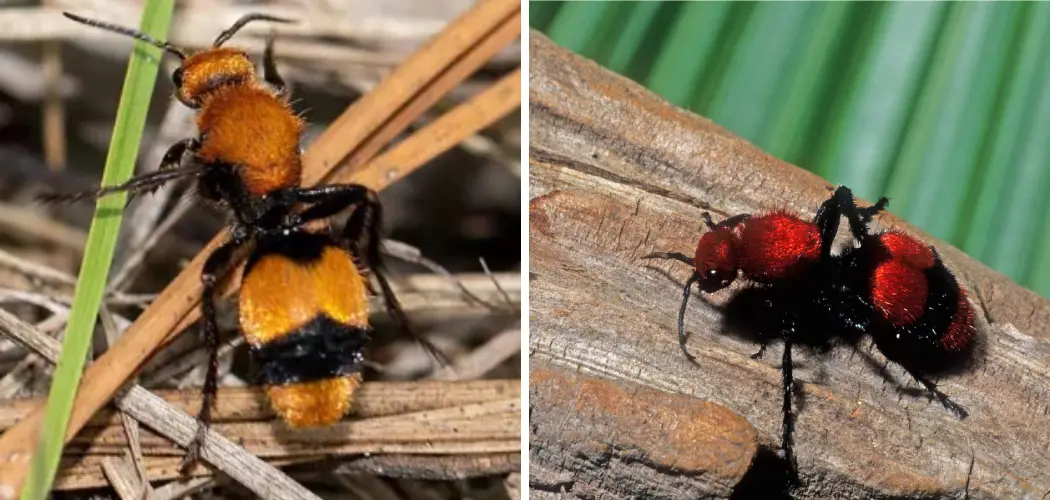Cow ants, also known as velvet ants or by their scientific name Mutillidae, are not actually ants but a type of wingless wasp. Despite their misleading name, these insects are known for their painful sting and distinctive, furry appearance, which can vary in color from bright reds and oranges to more subdued blacks.
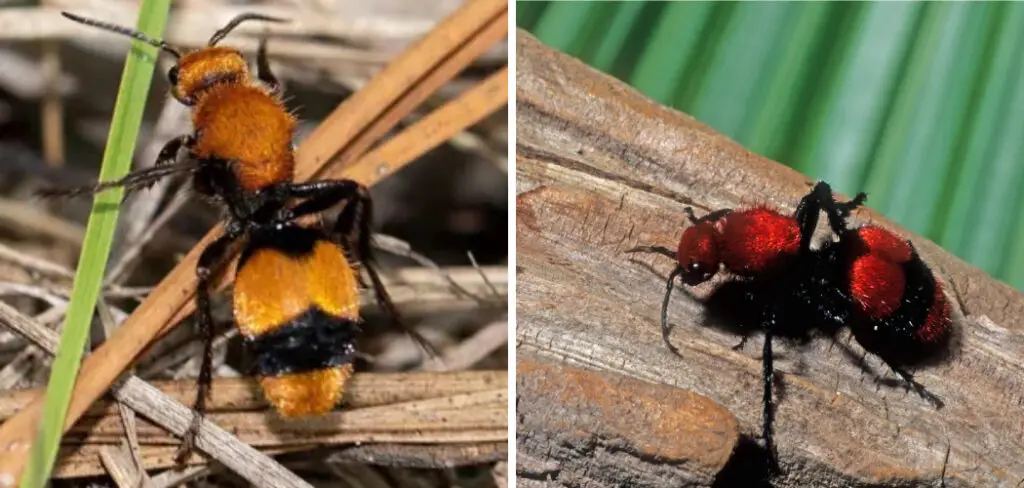
Due to their unique and sometimes intimidating presence, finding them around your home or garden can be a cause for concern.
In this guide on how to get rid of cow ants, we’ll explore effective strategies for deterring these insects and ensuring your outdoor spaces remain comfortable and cow ant-free.
What is a Cow Ant?
As mentioned, cow ants are not actually ants but rather a species of flightless wasps. They belong to the Mutillidae family and are known for their vibrant colors and dense, velvety fur that covers their bodies. Despite this fuzzy exterior, cow ants have powerful mandibles and stingers, making them a force to be reckoned with.
You may also hear people refer to cow ants as “cow killer ants” due to their painful sting. While it is not actually strong enough to kill a cow, the pain from a cow ant’s sting has been compared to that of being shot. Needless to say, encountering these insects can be a frightening experience.
Why are Cow Ants a Problem?
Cow ants are not typically considered a major pest, as they do not infest homes or cause significant damage to structures. However, their presence can be a nuisance and a potential danger in outdoor spaces.
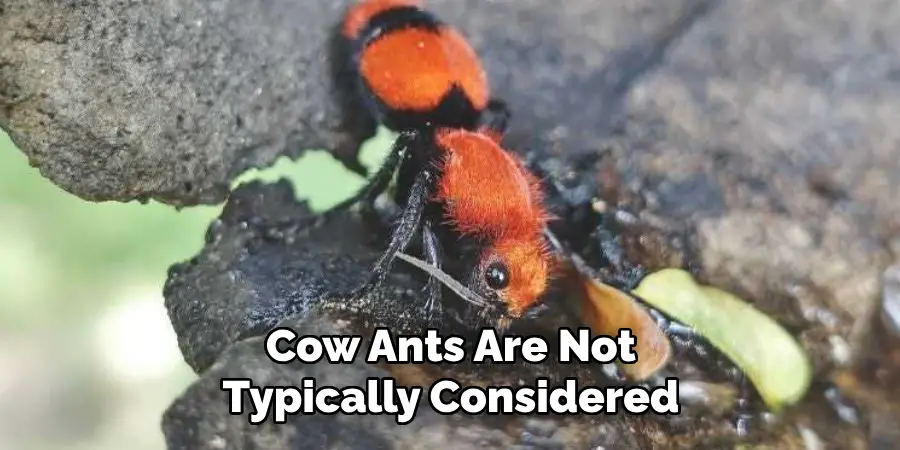
For one, cow ants can disrupt the natural balance of your garden by preying on other insects and pollinators. Additionally, their sting can be harmful to people and pets, especially those who are allergic or may accidentally disturb a cow ant’s nest.
Needed Materials
Before we dive into the strategies for getting rid of cow ants, it’s important to gather a few materials that will come in handy during the process:
Insecticide Spray or Dust:
Insecticides containing carbaryl, diazinon, or bifenthrin have been found to be effective against cow ants. These can be found at most garden centers and hardware stores.
Protective Gear:
Due to their painful sting, it’s important to wear protective gear when dealing with cow ants. This can include long-sleeved clothing, gloves, and face masks.
Natural Repellents:
If you prefer to avoid chemical solutions, there are natural repellents that can help deter cow ants. These include cinnamon, citrus peels, and peppermint oil.
10 Step-by-step Guidelines on How to Get Rid of Cow Ants
Step 1: Identify the Problem Areas
Before taking any action, it’s important to determine where cow ants are present in your outdoor spaces. Look for their distinctive, furry appearance and avoid getting too close as they can sting if provoked. The areas where you see the most cow ants will be the focus of your efforts.
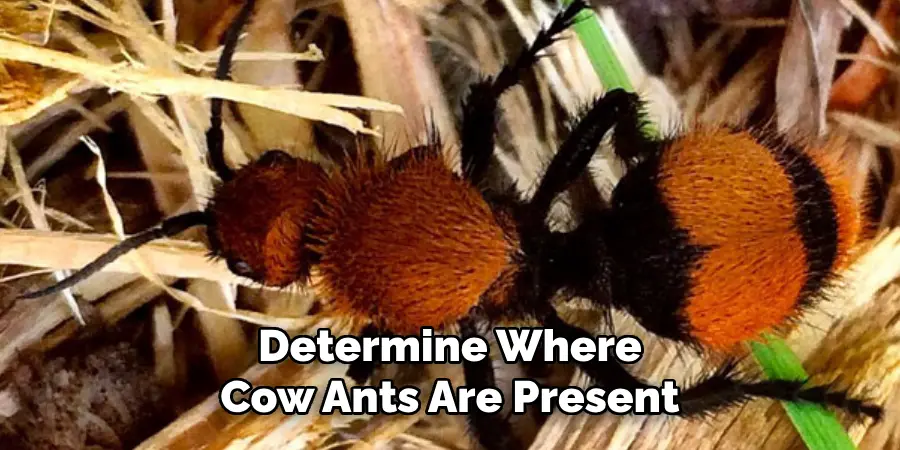
You may also want to take note of any potential nesting sites, such as under rocks or in loose soil. It’s important to be cautious when inspecting and treating these areas. The best time to do this is during the day when cow ants are most active.
Step 2: Remove Attractive Nesting Sites
Cow ants prefer dry, sandy soil for nesting. If you have areas of your yard with this type of soil, it’s important to reduce their attractiveness by incorporating moisture and dense foliage. This can be achieved through regular watering or planting shrubs and other vegetation.
It’s also a good idea to remove any debris or clutter from your yard, as these can serve as potential nesting sites. You may also want to seal any cracks or gaps in your home’s foundation to prevent cow ants from entering. It’s important to note that cow ants are not attracted to food, so keeping your outdoor spaces clean will not have much impact on their presence.
Step 3: Use Insecticide
If you’re dealing with a large infestation of cow ants, using an insecticide may be necessary. Follow the instructions carefully and apply it directly to their nesting sites. It’s important to wear protective gear and be mindful of any potential harm to other insects or pollinators in the area.
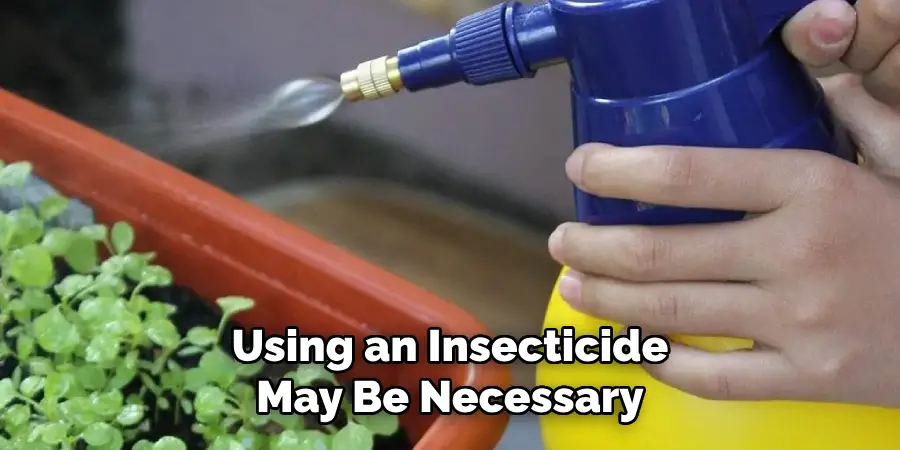
It may also be beneficial to treat the surrounding areas as cow ants can travel long distances. The best time to do this is in the morning or evening when cow ants are most active. It may take a few applications to eradicate the infestation fully.
Step 4: Set Traps
Traps are an effective way to catch and remove cow ants from your outdoor spaces. You can purchase traps specifically designed for cow ants or make your own using a combination of sugar water and insecticide. Place these traps in areas where you have noticed cow ants and dispose of them once they have been caught. But be cautious when handling the traps, as cow ants can still sting even after being trapped. The use of traps can also help to monitor the effectiveness of your other pest control efforts.
Step 5: Use Natural Repellents
If you prefer to avoid using chemicals, there are natural repellents that can help deter cow ants. Simply sprinkle cinnamon or place citrus peels around the area where cow ants are present. You can also mix peppermint oil with water and spray it in infested areas.
These natural repellents may not completely eliminate a cow ant infestation, but they can help reduce their presence and discourage them from nesting in your outdoor spaces. The added bonus is that these natural repellents are safe for other insects and pollinators.
Step 6: Try Diatomaceous Earth
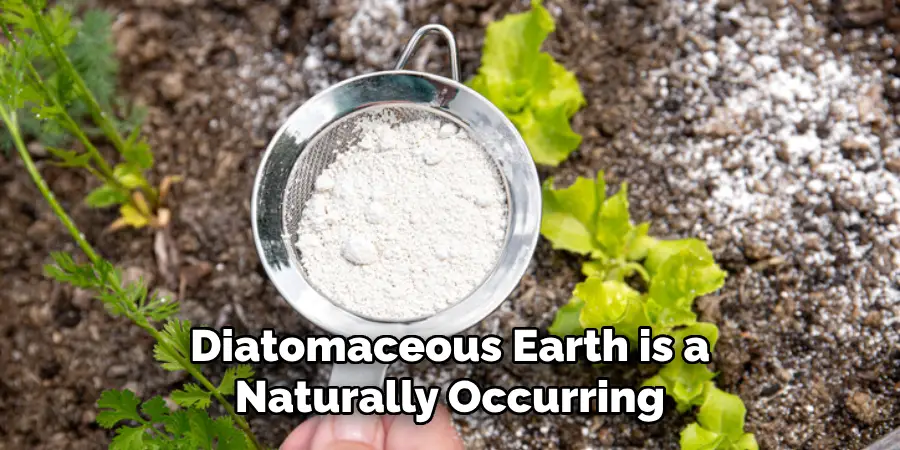
Diatomaceous earth is a naturally occurring, fine powder that is made from the fossilized remains of diatoms. It is a safe and effective way to eliminate cow ants as it dehydrates them upon contact. Simply sprinkle the powder in areas where cow ants are present and reapply after rain or watering.
The only downside to using diatomaceous earth is that it can also harm beneficial insects, so use it sparingly and only in areas where cow ants are present. You can purchase diatomaceous earth at most garden centers and hardware stores. It’s important to wear protective gear when handling and applying this powder.
Step 7: Use a Vacuum
If there are only a few cow ants in your outdoor spaces, you can simply vacuum them up and dispose of the bag or empty the canister far from your home. This method is only effective for small infestations, as cow ants can quickly repopulate an area.
The best time to vacuum cow ants is in the morning or evening when they are most active. But be cautious when vacuuming near their nests as they can become agitated and sting. The use of a vacuum can also help to remove any cow ants that may have found their way into your home.
Step 8: Consider Professional Help
If you’ve tried multiple methods and still cannot get rid of cow ants, it may be time to call in a professional pest control service. They will have the expertise and equipment necessary to effectively and safely remove cow ants from your outdoor spaces.
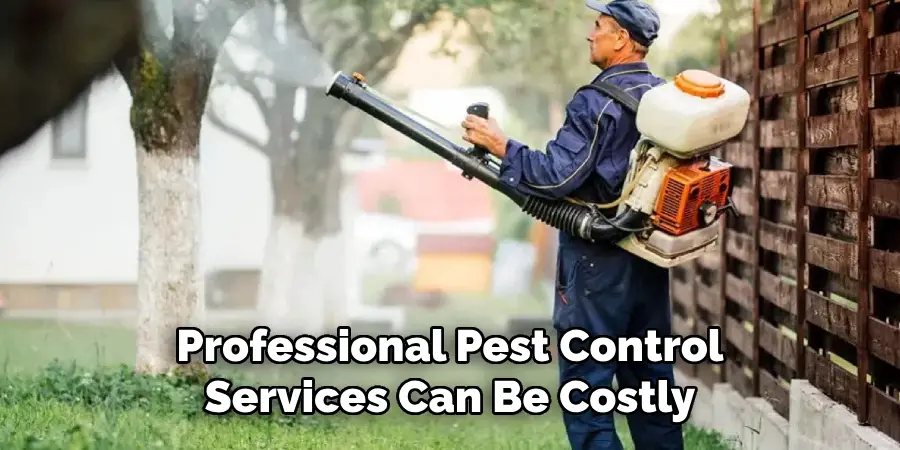
Be sure to do your research and choose a reputable company that uses eco-friendly methods. You may also want to inquire about ongoing pest control services to prevent future infestations. It’s important to note that professional pest control services can be costly, so only consider this option if other methods have been unsuccessful.
Step 9: Maintain Your Outdoor Spaces
Once you have successfully eliminated the cow ant infestation, it’s important to maintain your outdoor spaces to prevent future problems. Keep vegetation trimmed, remove any debris or clutter, and regularly inspect your yard for any potential nesting sites.
Also, natural repellents should be considered as a preventative measure to deter cow ants from returning. The key is to remain vigilant and address any issues as soon as they arise. It’s also a good idea to check your home’s foundation for any cracks or gaps and seal them as necessary.
Step 10: Educate Others
Cow ants are not only a nuisance but can also pose a threat to those with allergies or sensitivities to their sting. It’s important to educate others in your household, as well as visitors, about how to identify and avoid cow ants. This includes children and pets who may be more susceptible to their stings. By taking preventative measures and being aware of cow ants, you can ensure your own safety and comfort in your outdoor spaces.
Following these steps on how to get rid of cow ants can help you effectively and safely get rid of cow ants from your outdoor spaces. Remember, it’s important to remain proactive in preventing future infestations by maintaining your yard and educating others. With persistence and proper pest control methods, you can enjoy a cow ant-free outdoor environment.
Educating Stakeholders on Cow Ant Control
In addition to educating yourself and those in your household, it’s also important to educate others in your community about cow ant control. This can include neighbors, local businesses, and even city officials. By working together, you can create a more effective approach to controlling cow ants and preventing future infestations.
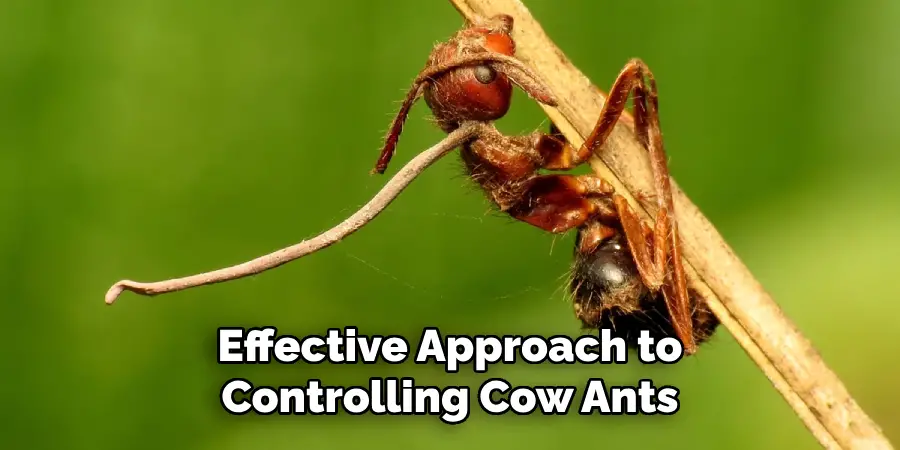
One way to do this is by organizing a neighborhood meeting or workshop to discuss the issue and share tips on how to get rid of cow ants. This can also be a platform to address any concerns or misconceptions about cow ant control methods, such as the use of chemical insecticides. By promoting environmentally friendly and safe pest control practices, you can help protect not only your own outdoor spaces but also those in your community.
You can also reach out to local businesses, such as garden centers and hardware stores, to encourage them to carry natural pest control products and educate their customers on how to use them effectively. Additionally, you can work with city officials to implement more eco-friendly pest control methods in public spaces, such as parks and playgrounds.
By educating stakeholders on cow ant control, you can create a more unified and effective approach to tackling the issue in your community. Remember, it takes a collective effort to successfully manage pest populations and maintain a healthy outdoor environment for all. So spread the word and work together towards achieving a cow ant-free community!
Collaboration with Pest Management Professionals
If you are dealing with a large or persistent cow ant infestation, it’s always recommended to seek the help of a professional pest management company. They have the knowledge, experience, and resources to effectively remove cow ants from your outdoor spaces. Not only can they safely use insecticides and other control methods, but they can also provide ongoing monitoring and prevention services to keep your outdoor spaces free of cow ants.
Additionally, they can offer advice on how to prevent future infestations and maintain a healthy and pest-free environment in your yard. Remember to always do your research and choose a reputable company that uses eco-friendly methods for pest control.
Collaborating with a professional can provide long-term solutions for managing cow ant infestations and ensure the safety and well-being of your outdoor spaces. So, if you are struggling to get rid of cow ants on your own, don’t hesitate to reach out to a professional pest management company for assistance. Together, we can effectively control cow ant populations and create a more enjoyable outdoor environment for everyone.
Frequently Asked Questions
Q: Do Cow Ants Only Live in Rural Areas?
A: No, cow ants can be found in both rural and urban areas. They are attracted to open spaces with plenty of vegetation and sandy soil for nesting. So, it’s important to take preventative measures regardless of your location. The steps outlined above can be applied to both rural and urban spaces.
Q: Are Cow Ants Dangerous?
A: While cow ants are not typically aggressive, they can pose a threat to those with allergies or sensitivities to their sting. It’s important to take proper precautions when dealing with them and seek medical attention if stung. But by following the steps outlined above, you can effectively eliminate cow ants from your outdoor spaces and minimize any potential danger.
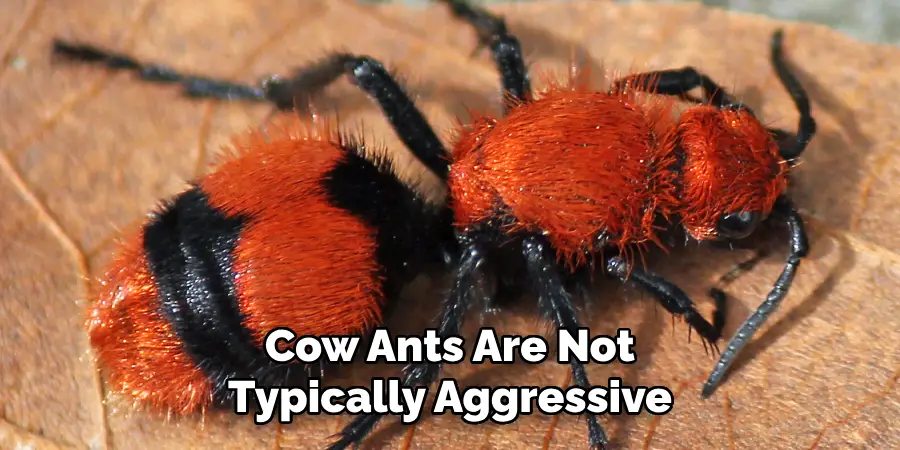
Q: Can I Use Any Insecticide to Get Rid of Cow Ants?
A: It’s important to choose an insecticide specifically designed for cow ants, as not all insecticides are effective against them. Additionally, be sure to follow the instructions carefully and use caution when handling and applying pesticides. Natural repellents and diatomaceous earth can also be effective alternatives to insecticides. Consult a professional pest control service if you are unsure about which method to use.
Q: How Quickly Can Cow Ants Repopulate an Area?
A: Cow ants can quickly repopulate in an area, as they have a high rate of reproduction. It’s important to address an infestation promptly and properly to prevent further issues. Regular maintenance and preventative measures can also help keep cow ants at bay and minimize their ability to repopulate in your outdoor spaces. Keeping your outdoor areas clean, trimmed, and free of clutter can go a long way in preventing future infestations.
Q: Can I Use Chemicals to Get Rid of Cow Ant Nests?
A: It’s important to use caution when trying to eliminate cow ant nests as they can become agitated and sting if disturbed. It’s best to consult a professional pest control service for the safe and effective removal of cow ant nests.
They will have the necessary equipment and expertise to handle the situation properly. Additionally, using natural methods such as diatomaceous earth or boiling water can also be effective in getting rid of nests without the use of chemicals. Always prioritize safety when dealing with cow ants and their nests.
Overall, by following these steps and being proactive in preventing future infestations, you can effectively get rid of cow ants from your outdoor spaces and ensure a safe environment for yourself and others. Remember to stay vigilant, educate others, and seek professional help if needed. With persistence and proper pest control methods, you can enjoy a cow ant-free outdoor environment. Happy pest control!
Conclusion
Successfully managing cow ant infestations in outdoor spaces is a multifaceted approach that requires persistence and adherence to best practices. From physical removal methods to the judicious use of insecticides and the importance of maintaining a clean, clutter-free environment, each step plays a crucial role in controlling the population of these pests.
Remember, prevention is key. By staying proactive about yard maintenance and educating those around you, you can mitigate the risks associated with cow ants.
Should an infestation prove stubborn or extensive, do not hesitate to call in professional pest control services to address the problem safely and effectively. Ultimately, the goal is to enjoy your outdoor spaces without the worry of cow ants, ensuring a safe and comfortable environment for everyone. Thanks for reading this article on how to get rid of cow ants.
You Can Check It Out to Kill Ants in Garden Bed
About
Outdoor Fixes is a distinguished figure in the world of Diy design, with a decade of expertise creating innovative and sustainable Diy solutions.
His professional focus lies in merging traditional craftsmanship with modern manufacturing techniques,
fostering designs that are both practical and environmentally conscious. As the author of diy,
outdoorfixes delves into the art and science of outdoorfixes-making, inspiring artisans and industry professionals alike.
Education RMIT University
(Melbourne, Australia) Associate Degree in Design (Outdoor Fixes) Focus on sustainable design, industry-driven projects,
and practical craftsmanship. Gained hands-on experience with traditional and digital manufacturing tools, such as CAD and CNC software.
Nottingham Trent University
(United Kingdom) Bachelor’s in outdoorfixes.com and Product Design (Honors) Specialized in product design with a focus on blending creativity with production
techniques. Participated in industry projects, working with companies like John Lewis and Vitsoe to gain real-world insights.
Publications and Impact
In diy, Outdoor Fixes his insights on indoor design processes, materials, and strategies for efficient production.
His writing bridges the gap between artisan knowledge and modern industry needs, making it a must-read for both budding designers and seasoned professionals.

